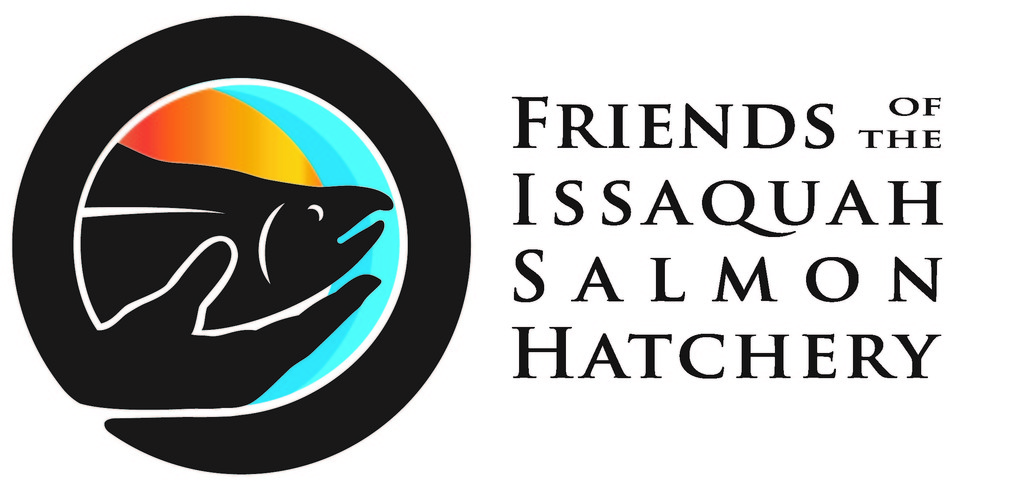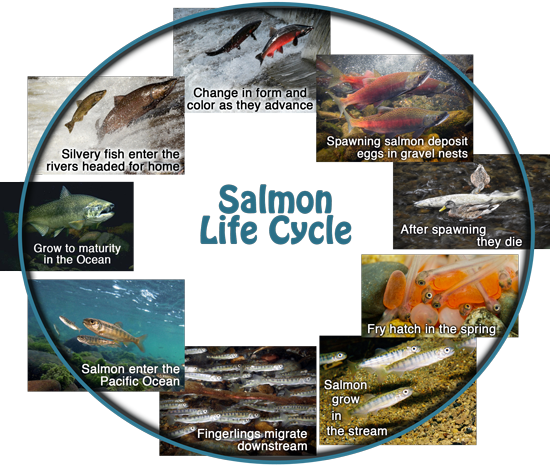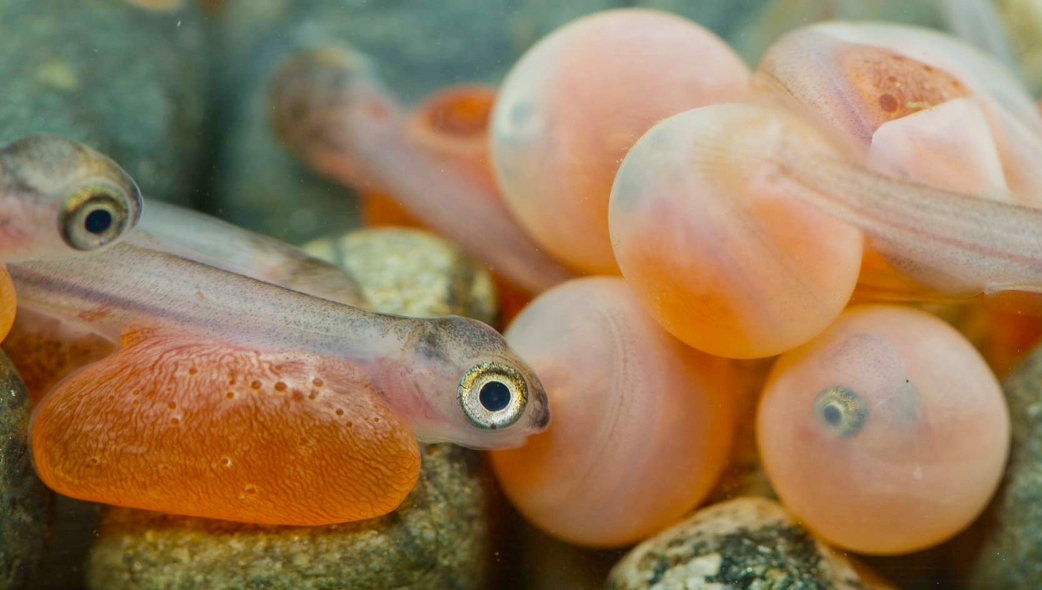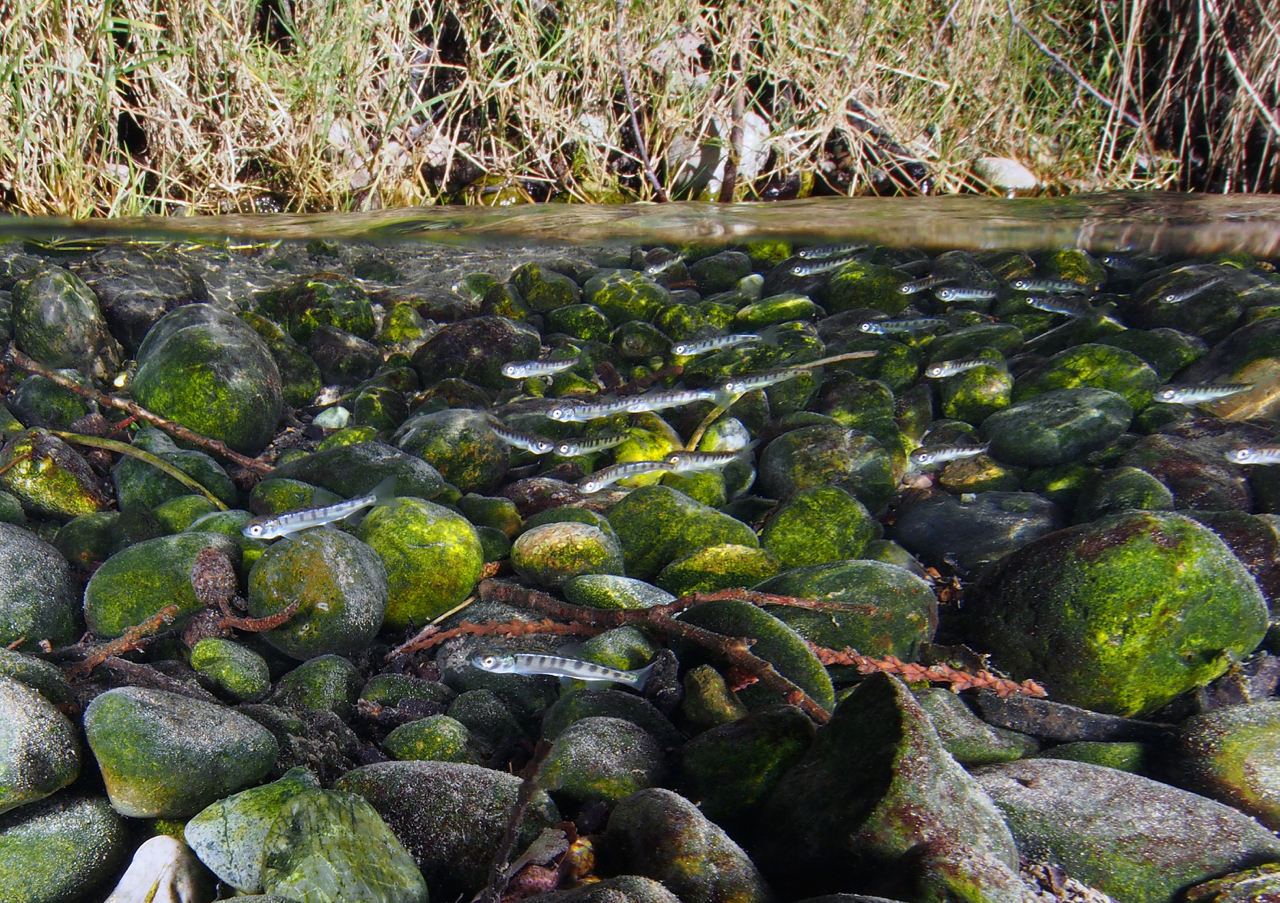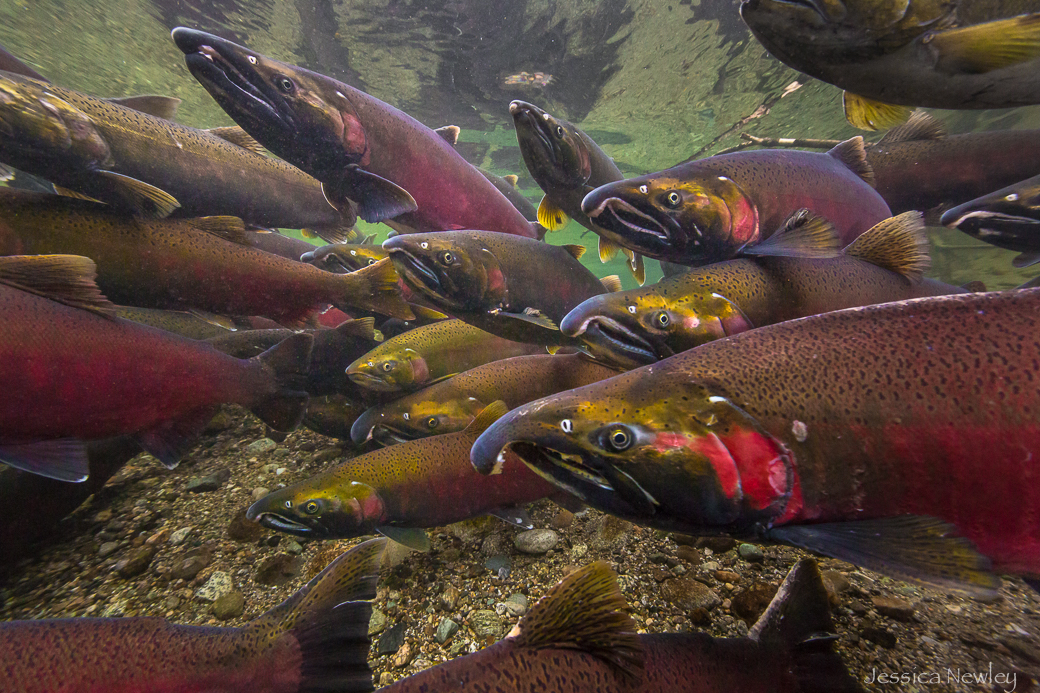Pacific Northwest salmon are one of the most spectacular migrating species of fish, completing a dramatic life cycle journey to spawn just once in their lifetime. Within their genetic fiber is an instinct that drives them along a monumental journey from their freshwater spawning beds downstream into the sea. There they spend several years, swimming thousands of miles, feeding on rich ocean resources, developing the size and strength they will need for a single return journey to their freshwater home stream in order to spawn. Throughout their life cycle, they face numerous hazards, both natural and human-made.
Click to Enlarge
Overview: The Eight Stages of the Salmon Life Cycle
1. Eggs
The female Pacific salmon (called a hen) deposits 2,000 to 5,000 eggs in her freshwater nest (called a redd). As she deposits her eggs into the redd, the male salmon (called a buck) fertilizes them. The eggs incubate, buried in the gravel. Cold water flowing through the gravel brings oxygenated water to them. In time they develop heads and bodies, and eyes begin to show.
2 & 3. Sac Fry & Fry
Once hatched, the small fish – called “sac fry” – spend their first eight weeks hiding in the gravel, where they live off the nutrition of their yolk sac. Gradually, they absorb their sac and become known as “fry.” The fry emerge from the gravel to forage for food. They are on their own in a big new world.
4 & 5. Fingerlings & Smolts
Depending on the species, young salmon may spend several months to as much as a year or more in the river before migrating downstream. They eventually grow to the size of a human finger and develop vertical strips on their sides (called parr marks). As they approach five to six inches, they migrate downstream. These small, ocean-bound salmon are called “smolts” and they are on their way to the estuary — where freshwater mixes with the ocean at the river’s mouth — and, eventually, to the ocean.
7. In the Ocean
In the ocean, salmon grow rapidly, as they feed on the ocean’s rich supply of food. They travel thousands of miles along the same paths as their predecessors, growing big and strong, preparing for the journey ahead.
7. The Journey Home
After two to five years in the ocean, salmon begin their instinctual journey from salt water back to the freshwater rivers and streams where they were born. This upstream migration is a series of hazards, and survivors of this journey are few. On average just two from their birth redd reach their home spawning beds.
8. Spawning
Hens and bucks that complete the amazing journey to their spawning beds pair up and spawn. Within days of spawning, both the hen and buck die, and their bodies decay and nourish the stream and surrounding forest. The life cycle can begin anew.
Let’s Take a Deeper Dive into the Salmon Life Stages
The hen builds a shallow depression in the gravel of a stream bed — which we call a redd (her nest) and deposits thousands of eggs into it. A buck, swimming alongside her, immediately fertilizes the released eggs as they drop into the redd. The hen quickly moves just upstream and, with a strong whip of her tail, flips up gravel to cover the eggs, burying them. It is important that the eggs remain hidden from predators and locked down to prevent them from being washed downstream by the current.
To incubate successfully, the eggs depend on cold, clean, oxygen-rich, flowing water to percolate (flow through) the gravel in which they are buried. The gravel must remain clean, with very little sediment (small particles) in order to allow the eggs to “breathe” the oxygen-rich flowing water. The flow also carries away waste product, which is important. Water temperatures must remain cold — between 40 and 65 degrees F (Fahrenheit). Salmon are cold-water fish and do not easily tolerate temperatures above 68 degrees F.
During the first month of incubation, the eggs are fragile and even a slight disturbance might destroy them. They are susceptible to many dangers:
Gallery: Eggs & Alevins
- Silt can smother them. Silt is fine sand or clay, eroded from the earth’s surface as water runs downhill. When trees and vegetation are removed from the land or destroyed (by construction, logging or wildfire), the land is exposed to the forces of nature. With enough rainfall, water carries sediment downhill, coloring the water brown as it picks up particles of earth. Streams and rivers turn muddy brown with suspended sediment. These fine particles eventually settle to the bottom as silt. Silt fills the empty spaces between rocks and gravel — where salmon eggs are buried and incubating. Too much silt can devastate eggs by smothering them.
- High stream flows during heavy rainfall can scour (drastically erode) stream beds, tumbling gravel and eggs downstream, killing the eggs.
- Predators feed on eggs. As they forage the stream bed for food, their movements through the gravel can crush or trap the buried eggs.
- Low water levels. During long periods of dry weather, water flows in smaller streams can drop so low that stream side channels — which flow when water is plentiful — can run low and even stop flowing. Many of these side channels are used by salmon to spawn, and those redds can become isolated in side pools, cut off from the flowing stream. The side pools are small and vulnerable to warming by the sun. Without incoming flow, eggs and developing young salmon may suffocate as oxygen in the small pools is used up and not replenished.
On average, only about 10 percent of the eggs deposited in a redd survive. For survivors, after roughly a month of incubation, head and body regions begin to develop and eyes begin to show.
Within a few months, in late winter or spring, the eggs hatch and are called sac fry, or alevin. A sac fry is a fragile creature with huge eyes and a large yolk sac protruding from its belly. The orange sac contains a balanced diet of proteins, carbohydrates, minerals and vitamins. Sac fry remain in the gravel and live off their yolk sac, growing rapidly for one-to-three months.
By remaining under the gravel, sac fry are protected from most predators and other hazards. They continue to rely on clean, porous (lots of spaces in-between) gravel to allow flow of oxygen-rich water.
By late spring and summer, when surviving sac fry have absorbed all of their yolk sac, they must emerge from the gravel to find food. They are now about one inch long and are called fry. Fry feed on plankton and small insects and rely on good streamside cover (such as overhanging trees, grasses, and shrubs as well as woody debris such as logs and dead branches) for protection from predators and keeping the water cool. Fry stay in shallow pools near the edge of the stream where the current is not too strong. They are easy prey for trout and other large fish as well as birds.
When the young fish reach the size of a human finger, they are called — appropriately enough — fingerlings. They now have vertical marks (parr marks) along their silvery sides to help them hide from predators. They continue to grow rapidly.
When they reach approximately four to six inches in length, instinct drives them to migrate downstream toward the ocean. They are now called “smolts.” They travel mostly at night to avoid predators who hunt by sight. Interestingly, most smolt drift backwards downstream, with their head facing upstream.
Throughout this migration, they are confronted by many hazards, including potentially low water in streams, reservoirs which interrupt the natural downstream flow of water, predatory birds from above, dams and other man-made changes to the river channel, and predatory fish and mammals. Ample water flow is a critical factor during downstream smolt migration. High flows mean higher survival rates.
Up to 90 percent of salmon that hatch never reach the sea.
Survivors that reach the estuary — where river water mixes with the sea — experience big changes to their body as they make the remarkable transition from freshwater to saltwater. (Imagine having to adjust to drinking ocean water?! Hint: it would kill us.) This physical change is called smoltification. Their parr marks disappear and their bodies become silvery but also “counter-shaded” (dark above and light below) which will help them avoid ocean predators. Once adjusted, they head out to sea as young salmon.
INSERT A SMALL SECTION HERE THAT DISCUSSES LIFE IN AN ESTUARY.
Gallery: Fry, Fingerlings & Smolts
- The Salmon Life Cycle
The amount of time salmon spend in freshwater varies by species:
- Chinook are interesting::
- “Yearlings” spend a year in freshwater.
- “Sub-yearlings” spend just a few months to 6 months.
- Coho and sockeye spend a year or more in freshwater.
- Pink and chum migrate soon after emerging as fry!
Dams drastically alter the natural flow of river systems. The reservoirs behind dams present challenges and dangers: 1) smolts must now navigate across a human-made lake, which critically delays their progress, and 2) as they do so, they are vulnerable to lake predators, both fish and birds. Many smolts are eaten in the journey, and survivors are significantly delayed in reaching the estuary, which can critically impact their transition to saltwater. Dams themselves present hazards: 1) smolts are injured and killed as they pass through hydroelectric turbines or 2) fail to find human-made passageways downstream. Some pass into unscreened irrigation ditches and become stranded in farm fields.
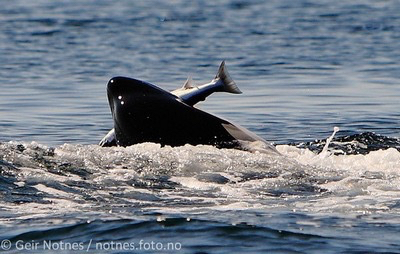 The amount of time that salmon spend at sea varies by species:
The amount of time that salmon spend at sea varies by species:
- Chinook, Sockeye and Chum: spend 3 to 5 years at sea.
- Coho: most spend 3 years at sea.
- Pink: spend exactly 2 years at sea.
The sea is rich in food sources and salmon grow rapidly. Phytoplankton (microalgae — tiny plants — that float in the water wherever light is able to penetrate) are the first food source for young salmon. Ocean temperatures have much to do with how much phytoplankton is available. Warmer water reduces the amount of phytoplankton, and therefore greatly impacts the survival of young salmon.
As they grow, their diet evolves to shrimp and krill. Some species move on to herring, sand lance, anchovy and others. However, they also face encounter predators, such as sharks, orcas, other marine mammals, and commercial and recreational fishers.
Where Do Issaquah Salmon Go?
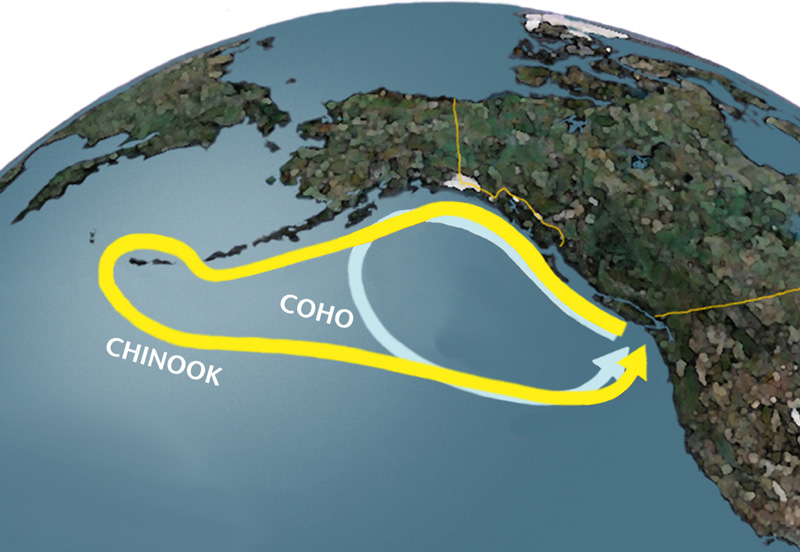
- Most Puget Sound salmon (including those reared at the Issaquah Salmon Hatchery) emerge from the Strait of Juan de Fuca and enter the Pacific Ocean, following the British Columbia coast north.
- Some salmon turn south and live off the Oregon coast.
- A few remain in Puget Sound. Chinook that stay in the Puget Sound are referred to as “Blackmouth“, based on the black gumline characteristic of Chinook. Blackmouth used to support a significant winter sportfishery, but the numbers of these Chinook have declined greatly in the last decade.
The Alaska Current
Of the majority of salmon who swam north in the Pacific Ocean, Chinook swim as as far as the Aleutian Islands of Alaska. They travel down-current in what is called the Alaska Current — which is a huge counterclockwise circular current nestled under Alaska and the Aleutian islands. INSERT PICTURE. Swimming downcurrent makes their journey easier as they cover long distances. This current is important because it upwells (brings up from below) nutrients from deeper waters. These nutrients feed the phytoplankton, forming a strong basis for life in the oceanic food web, in which salmon can thrive. Unfortunately, as global warming occurs, less nutrient-rich water is brought to the surface, providing less food to salmon. EXPLAIN WHY THAT OCCURS. IS THERE LESS CURRENT?
How Long Do Salmon Stay in the Ocean?
It varies by species:
- Chinook: 3-5 years
- Coho: 3 years
- Sockeye: 3-5 years
- Pink: 2 years
- Chum: 3-5 years
Returning salmon are referred to as “1 salt fish” if they return after one year in the ocean, then “2 salt fish”, and so on. A typical 12-pound Chinook returning to the Issaquah Salmon Hatchery is a 3 salt fish, while a 20 pound Chinook is likely to be a 4 salt fish. The largest Chinook on record weighed 127 pounds, and is speculated to have been at least a 9 salt fish!
Growing to Maturity
While in the ocean, salmon concentrate on feeding and adding to their body mass, especially fats. These fats will be their energy reserves for what will be a long, difficult upstream migration to spawn. These fats are also why animals, such as orcas, sea lions, sharks and humans love salmon, because these fats make salmon delicious to eat.
Once their body matures to a certain point, instinct drives them to reverse course and begin the journey back to their home stream. The salmon who swam north in the Pacific Ocean will now swim against the Alaska Current. Salmon off the course of Oregon head north for their return journey.
Return Signals
What is it exactly that signals to salmon that it is time to leave the ocean and start the migration back to the Puget Sound? What drives their urge or knowledge to turn back? It is instinct and hormones — the biochemicals within mature animals that drive the urge to reproduce. [I NEED TO RESEARCH WHETHER THE TRIGGERS FOR THIS CHANGE ARE KNOWN.]
How Salmon Navigate: the Science and the Mystery
Scientists have studied the navigation of salmon in the ocean for decades, and although a great deal is known, there are still mysteries to unravel.
It is known that salmon can detect the Earth’s magnetic field and that tiny changes in this magnetic field will cause our returning “northern” salmon to travel down the British Columbia coast — either east of Vancouver Island via the Strait of Georgia, or on the west side of Vancouver Island — to enter the Puget Sound via the Strait of Juan de Fuca.
It has been speculated that salmon may navigate by the position of the stars. However, given that there are generally 200 or more overcast days per year in the northern Pacific Ocean, this seems unlikely.
Finally, it is well known that when salmon approach their natal (home) stream, they navigate by smell. Every stream has a unique smell, made up of minerals that are dissolved in the watershed, and other microorganisms, such as algae. For example, even the coal pollutants from abandoned coal mines in Squak and Tiger Mountains lend a distinctive smell to Issaquah Creek. Young salmon learn those smells and use them to guide them home.
LET’S UPDATE THESE GALLERY CAPTIONS TO WALK THE USER THROUGH THE DIFFERENT VISIBLE PHYSICAL CHANGES. While salmon are developing as they travel northward in the Pacific Ocean, their reproductive organs – eggs sacs in the females, testes in the males – are very small. However, as instincts and urges drive them to reverse course and head home, salmon begin to go through remarkable physical changes, particularly as they re-enter the freshwater. Their skin thickens and bones soften. The changes that males go through are the most physically obvious and dramatic, developing hooked jaws, sharp teeth and, in some species, bright colors. Some examples include:
- Chinook take on a darker color, usually a dark brown with enlarged black spots, and some of the males develop red highlights on their sides.
- Coho become much more colorful, with the males sometimes developing very red sides.
- Sockeye develop red bodies and green heads.
- Pink males develop particularly large humps. (Males of all species develop humps, but pinks are the most pronounced, which explains their other name: humpies.)
- Chum develop blotchy, vertical stripes across their sides.
Gallery: Changes in Migrating Salmon
Interestingly, some salmon return as very small adults, usually weighing less than a pound. These are referred to as “jacks” and may have never even left the Puget Sound. They are sexually mature and capable of fertilizing eggs. Just like their larger brothers, they die after they spawn. Also interesting is that the vast majority of these “early returners” are male (hence the name “Jack”) and very rarely does a female return early. When she does, she is called a ‘Jill’. They are very rare.
But there is another remarkable change going on inside a female salmon’s body: she is converting body mass (stored fats and muscle) to create thousands of eggs inside her, all of them rich in fats and protein. By the time a female approaches her spawning grounds, 20% of her body weight is eggs.
Once in Fresh Water, They Stop Eating
After almost constant eating throughout their lives, salmon do a remarkable thing when they re-enter fresh water: they stop eating. Remarkably, they will complete their entire upstream migration and spawning while living entirely off of their fat reserves. The length and arduousness of their upstream migration actually vary by species, with Chinook claiming the long-distance prize.
How do Chinook do it? The answer is: the farther a salmon has to travel upstream, the more stored body fat it requires. Chinook have evolved to be a “fatty” fish (prized for their delicious flavor, by the way) designed for long-distance upstream migration. And even among different runs of Chinook, those whose spawning grounds are hundreds of miles upriver have evolved to be fattier Chinook, allowing them to make the particularly long journey. This is to say: not all salmon of the same species are necessarily alike. You will learn in upcoming lessons that salmon have evolved and become specialized for their home streams.
The Endurance and Hardship of Upstream Migration
As salmon swim past the river estuary on their way upstream, they face a new series of challenges that will test their endurance. Dams built for hydroelectricity, flood control and water supply can block passage upriver. While most dams now have fish ladders to enable salmon to bypass the dams, simply finding them demands part of a salmon’s limited energy resources. Reservoirs behind the dams delay their upstream progress as their migrating instincts are confused by the still water. As they continue to make their way upstream, landslides and log jams can present unexpected new barriers. Waterfalls and rapids challenge salmon and test their endurance. Salmon often suffer visible injuries, adding to the many challenges. Anglers (fishers), bears, other mammals, and eagles take salmon along the way. When flows become too low for upstream migration, salmon may be delayed and must wait in holding pools until there is enough flow to enable upstream passage. Water temperatures may increase as they wait in these pools, creating conditions that promote disease outbreaks among fish. Delays decreases their chances for successful spawning.
When salmon finally arrive at their natal stream and are ready to spawn, the female (or hen) searches for a suitable place for spawning and then prepares a nest, called a “redd”. Swimming on her side and using her tail, she digs a 12 to 18-inch depression in the gravel of the stream bed. DESCRIBE HOW MALES COURT THE HEN. She then deposits between 3,000 to 5,000 bright pink eggs into the redd, and as she does so, the buck quickly fertilizes the eggs with milt (a milky white substance containing sperm). The hen moves upstream of the redd and, with her tail, she flips gravel back over the eggs to bury and protect them.
She remains with her redd for her remaining few days, defending it from disturbance by other hens. The buck swims off, possibly to fertilize eggs of other hens.
End of Life: They survived a remarkable journey full of challenges and hardship which took them thousands of miles in order to propagate the species. By the time salmon have spawned, their fat content is depleted. Within just a few days, both the hen and buck die. Their carcasses drift downstream and decay, and what’s left of the protein in their bodies goes on to feed a wide array of scavengers and nourish the watershed and ecosystem that gave them life.
